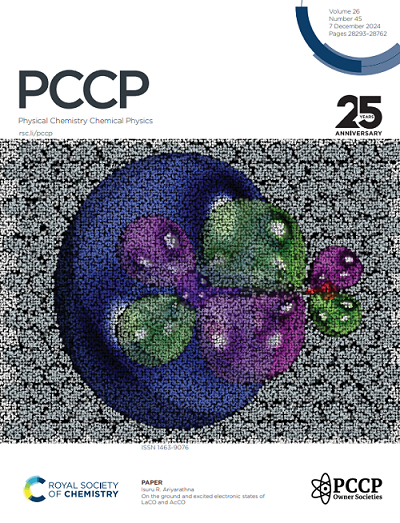外围 F-/H 原子和叔丁基取代基在轴向取代钛酞菁电荷转移中的作用
IF 2.9
3区 化学
Q3 CHEMISTRY, PHYSICAL
引用次数: 0
摘要
由于C-F键对电子云的吸引,F16TiOPc和轴向配体C60之间的电荷转移(CT)特性很差。此外,外围取代h原子或四叔丁基可以有效地改善CT特性,四叔丁基的σ - π超共轭效应也可以获得优异的单/双光子吸收性能。本文章由计算机程序翻译,如有差异,请以英文原文为准。


The role of peripheral F-/H-atoms and tert-butyl substituents in charge transfer of axially substituted titanium phthalocyanines†
A poor charge transfer (CT) characteristic between F16TiOPc and axial ligand C60 is observed due to the attraction of the C–F bonds to the electron cloud. In addition, the CT characteristic can be effectively improved by peripheral substitution of H-atoms or tetra-tert-butyl groups, and superior one-/two-photon absorption properties can also be achieved owing to the σ–π hyperconjugation effect in tetra-tert-butyl groups.
求助全文
通过发布文献求助,成功后即可免费获取论文全文。
去求助
来源期刊

Physical Chemistry Chemical Physics
化学-物理:原子、分子和化学物理
CiteScore
5.50
自引率
9.10%
发文量
2675
审稿时长
2.0 months
期刊介绍:
Physical Chemistry Chemical Physics (PCCP) is an international journal co-owned by 19 physical chemistry and physics societies from around the world. This journal publishes original, cutting-edge research in physical chemistry, chemical physics and biophysical chemistry. To be suitable for publication in PCCP, articles must include significant innovation and/or insight into physical chemistry; this is the most important criterion that reviewers and Editors will judge against when evaluating submissions.
The journal has a broad scope and welcomes contributions spanning experiment, theory, computation and data science. Topical coverage includes spectroscopy, dynamics, kinetics, statistical mechanics, thermodynamics, electrochemistry, catalysis, surface science, quantum mechanics, quantum computing and machine learning. Interdisciplinary research areas such as polymers and soft matter, materials, nanoscience, energy, surfaces/interfaces, and biophysical chemistry are welcomed if they demonstrate significant innovation and/or insight into physical chemistry. Joined experimental/theoretical studies are particularly appreciated when complementary and based on up-to-date approaches.
 求助内容:
求助内容: 应助结果提醒方式:
应助结果提醒方式:


